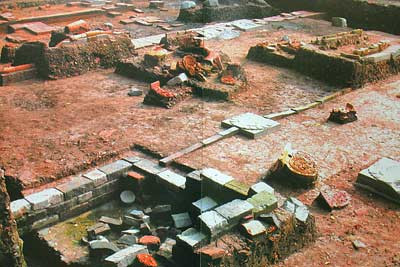Hanoi (VNA) - A workshop on the history of excavation of the Thang Long ImperialCitadel was held by the French Cultural Centre (L'espace)and the Vietnam Academy of Social Sciences (VASS)’s Institute of Archaeology in Hanoi on December 12.
Theevent was part of activities to celebrate the 45th anniversary ofVietnam-France diplomatic ties and 25 years since the formation of the French Academy ofthe Far East (EFEO) in Hanoi.
Scientists, experts and archaeologists at the event shared their storiesrelated to archaeological excavation at the citadel.
Dr.Nguyen Gia Doi, Director of the Institute ofArchaeology underlined thesignificance of the event which spotlights cooperation between Vietnamese andFrench archaeologists during the excavation of the the Imperial Citadel.
Many French research projects on cultural heritagepreservation have been highly appreciated by Vietnamese researchers, Doi said, affirmingthat Thang Long Citadel is an invaluablecultural heritage of Vietnam.
Prof. Dr. Andrew Hardy, Chief Representative of the EFEO said the ThangLong Citadel is a relic complex associated with the history of Thang Long ImperialCity, affirming this massive architecture structure has become the mostimportant relic in the system of Vietnamese relics as it reflects manyhistorical events.
Sharing the excavation process of the relic site, Associate Professor, Dr. TongTrung Tin, who was in charge of the excavation project, said the excavation from2002-2004 aimed to carry out a survey for the construction of the National Assembly (NA) House. Theearliest remains discovered at the site quickly attracted the attention of domesticscientists and those from international organisations.
In December 2002, the excavation was made on a total area of 19,000 sq.m at the the centre of Ba Dinh political area. The largestarchaeological excavation in Vietnam and in Southeast Asia revealed traces ofthe Thang Long Imperial Citadel during its 13-century history.
Uniquearchitectural traces and millions of valuable artifacts reflect the historyfrom Chinese domination (the 7th-9th century), throughoutthe dynasties of Ly, Tran, Le, Mac and Nguyen (1010-1945).
Tinstressed the need to build a plan to preserve the relic site while expandingthe excavation.
On the occasion, a book on the excavation of the site published by the The Gioi (World) Publishing House and the Institute of Archeology wasintroduced to participants.-VNA





























